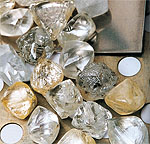African Diamond Producers Association: Transforming Africa’s Diamonds
Formed in November 2006, the African Diamond Producers Association is an ambitious new body embracing every aspect of diamond production. Executive secretary Eng. Edgar Diogo de Carvalho explains the organisation’s mission to Nigel Ash.
Nigel Ash: How would you characterise the objectives behind the African Diamond Producers Association (ADPA) and the benefits that it offers?
Eng. Edgar Diogo de Carvalho: One of the main objectives was to create a forum and framework where members could discuss their common interests and act in a harmonised way. It is a strategic platform of cooperation that coordinates the interests and efforts of member countries in promoting a dynamic and sustainable diamond industry in Africa, with the aim of significantly contributing to the stability of the continent and the prosperity of its people.
My role as executive secretary includes the promotion and development of technology and human resources to maximise the potential of diamond producers among member countries. The ADPA is working as part of the Kimberley Process to obtain a better performance for African diamonds in the world markets and to promote a positive image of the African diamond industry. Our intention is to extend the chain of diamond activities in Africa, starting with production and cutting, to enable Africa to become a major producer of diamond jewellery.
How would you describe the major challenges facing the African diamond industry?
As you know, many African countries are recovering from armed conflicts and most have been trying to consolidate their diamond industries. Some are still in the geological process of locating their diamond deposits. However, Africa still produces 60% of the world’s diamonds. Where diamonds are still being produced in conflict areas, we are cooperating with the Kimberley Process to try and stop those diamonds from being mined and sold.
How does the ADPA’s executive structure work?
The ADPA has 18 member countries of which 11 are permanent members and seven are observers. The executive is drawn from permanent member countries. For instance, I am from Angola, our technical secretary is from Guinea Conakry, and the deputy executive secretary for finance and administration is from South Africa. The executive secretariat reports to the ADPA’s Council of Ministers, which is made up of mining ministers from member countries. The council’s president serves for one year. At the moment, the office is held by the Angolan minister but when the ADPA council holds its second annual meeting this year in South Africa, the South African minister will take over.
Are there any African diamond producing countries that are not yet members?
Yes. Botswana and Lesotho are not yet members but we look forward to having them join.
The task of harmonising standards and policies within member countries must be a challenging one. How is it being addressed?
The key is to identify best practice from the experience of member countries. We recently ran a seminar on mining and tax policies. The idea is to have countries share successful experiences of working within one or more sectors of the diamond industry. This is not a simple process because each country has been implementing its own policies. But there has been considerable interest in the debate and a general belief that it will lead to something very pertinent.
We have countries with considerable experience of tax policies such as Namibia and Ghana, which has sound experience in jewellery production. We also have countries that work hard on the implementation of social projects in production zone areas. These are some of the key issues where we share best practice between our members. Taken together, they offer an attractive environment for investors that can help producing countries maximise their revenues from diamond production.
What is ADPA’s relationship with the African Union (AU)?
This is what I referred to at the beginning when I talked about cooperation. ADPA has already been recognised by the AU and the UN. We have been invited by the AU to become part of a tax focus group for the creation of a bourse for commodities in Africa, so we are working with them very closely.
How far has the bourse project proceeded?
ADPA is giving its support to the first diamond bourse, which will be located in the Democratic Republic of Congo. This will be the first of five diamond exchanges that we are planning to have in Africa. This idea was welcomed by our members and we are meeting with the president of the International Federation of Diamond Exchanges, which is supporting the first bourse. The establishment of these bourses, which will be for both finished and rough diamonds, will change not only the image of African diamonds, but will also improve their reputation.
By doing the cutting, polishing and jewellery making, is Africa seeking to take back value-added work undertaken elsewhere?
This is one of the major purposes of ADPA and we are looking to cooperate with those countries that already have experience of adding value to diamonds, such as Angola, Namibia and South Africa. We would like to stop exporting rough diamonds. Our intention is to finish a major portion of the diamonds here in Africa.
At the moment, the proportion of finished diamonds coming from Africa is still quite low, is it not?
Exactly. We are well aware of this, but things are already changing. For example, Angola is about to complete the construction of a polishing facility that will allow local diamonds to be prepared before they are exported to other countries. We will share this experience with other countries that are eager to establish similar factories.
Looking at ADPA’s economic, social and political goals, do you have any evidence that suggest Africa’s diamond trade can be properly regulated?
We have a consulting company doing a study on this but we do not yet have the results. However, I can assure you that the benefits will be significant, and there will be more investment in ADPA countries. We can then ensure there will be a revenue that can be used in other economic sectors of ADPA countries such as education, agriculture, health care and commerce.
Are you looking for non-African investors or international mining companies?
Both options would be good for us. We mean to attract companies with large technological and financial capacities that want to form a joint venture with local companies. For example, in Angola, all the major diamond companies operate, including de Beers and BHP.
Are you ever going to stop blood diamonds, or at least reduce the trade and make the job of the criminals more difficult?
We try to stop the criminals, or at least make it very difficult for them. The bourses will aim to fix the real prices of diamonds, creating an incentive for people to sell them legally. The policy of ADPA is that African diamonds should be produced outside of conflict zones; in areas controlled by governments. We are establishing the best way to evaluate the implementation of this policy. At the level of the artisan producer, we are looking to set up a form of cooperative, and provide training. But we need to strengthen the local trade in diamonds and make it impossible for diamonds to cross borders. The bourses that we are seeking to implement will be set up close to production zones.
Is the Kimberley Process a big part of this programme?
ADPA agrees with all the requirements of the Kimberley Process. We are looking to guide the member countries to comply with its requirements. We need to encourage the improvement of the trade in diamonds within our member countries. We have had concrete successes: the Republic of the Congo and Liberia have both been re-admitted to the Kimberley Process after a long period of suspension. They had to work hard to ensure that their diamonds could pass a certification process. We do not want to see blood diamonds used to fund conflicts.
Those countries that have complied with the Kimberley Process have been encouraged to share that experience with other member countries in such a way that we can avoid further constraints. We have asked the Democratic Republic of Congo, which has a very good trade system, along with the Republic of Ghana, Angola and Namibia, to help other countries that still face some challenges. I believe that as far as the Kimberley Process is concerned, we have a very frank and open cooperation. And at this moment, all ADPA member countries are committed to supporting the Ivory Coast, which is still under sanctions of the Kimberley Process.
Another important part of the brief for ADPA is sustainable development. All mining, not just of diamonds, can be very challenging for the environment. What is ADPA’s environmental role?
We hope to have a resolution that will address this issue. In the seminar on the harmonisation of diamond legislation and tax policies, we would like to have a resolution on the environmental effects of diamond production. We are seeking to establish a framework that approves the environmental impact of a mine before the start of production. We want to see clauses that will deal with the restoration of former mine sites so that they can be used for other economical ventures.
This process is being applied to Angola’s old diamond mining areas, which are being restored. Most are being used for agriculture. This is a policy that we want to share with all our member countries. We are also aware of the social problems that mining creates and want to make sure that environmental effects are minimal.
One big input for diamond mining is water. Is water now being recycled and filtered?
We have established a protocol that water used to wash diamonds is cleaned and recycled so it does not create health problems for the population down river. This is one of the policies that ADPA is seeking to implement with all its member countries - that diamonds should be produced with minimal environmental impact whatever that impact might be.





